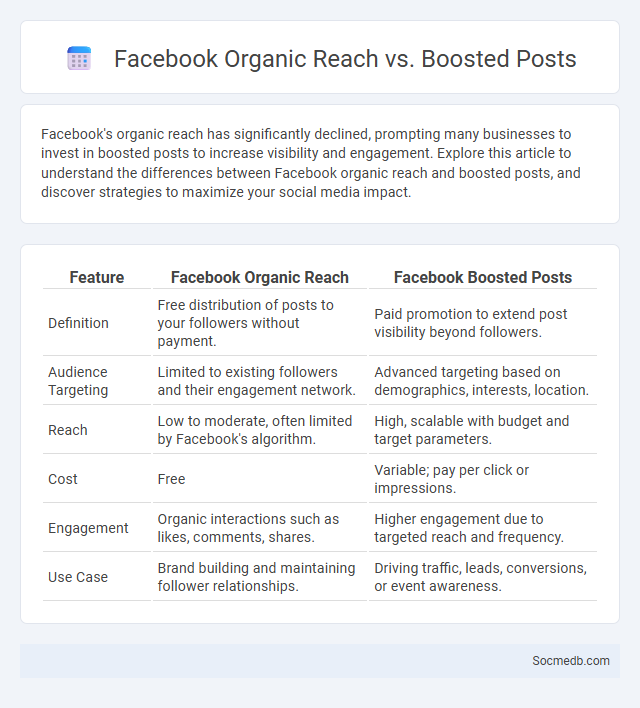
Photo illustration: Facebook Organic Reach vs Boosted Posts
Facebook's organic reach has significantly declined, prompting many businesses to invest in boosted posts to increase visibility and engagement. Explore this article to understand the differences between Facebook organic reach and boosted posts, and discover strategies to maximize your social media impact.
Table of Comparison
| Feature | Facebook Organic Reach | Facebook Boosted Posts |
|---|---|---|
| Definition | Free distribution of posts to your followers without payment. | Paid promotion to extend post visibility beyond followers. |
| Audience Targeting | Limited to existing followers and their engagement network. | Advanced targeting based on demographics, interests, location. |
| Reach | Low to moderate, often limited by Facebook's algorithm. | High, scalable with budget and target parameters. |
| Cost | Free | Variable; pay per click or impressions. |
| Engagement | Organic interactions such as likes, comments, shares. | Higher engagement due to targeted reach and frequency. |
| Use Case | Brand building and maintaining follower relationships. | Driving traffic, leads, conversions, or event awareness. |
Introduction to Facebook Content Strategies
Effective Facebook content strategies revolve around understanding audience demographics and leveraging engagement metrics to tailor posts that maximize reach and interaction. Utilizing a mix of visual content, such as images and videos, alongside compelling storytelling increases user retention and brand loyalty. Analyzing Facebook Insights enables continuous optimization, ensuring content aligns with user preferences and platform algorithms.
Understanding Facebook Organic Reach
Facebook organic reach refers to the number of unique users who see your content without paid promotion, a key metric for measuring genuine engagement and audience interest. Changes in Facebook's algorithm prioritize content from friends and family, reducing organic visibility for business pages, which means your posts must be highly relevant and engaging to maximize reach. Understanding how factors like post timing, content type, and audience interaction affect organic reach empowers you to optimize your social media strategy effectively.
What Are Facebook Boosted Posts?
Facebook Boosted Posts are paid advertisements designed to increase the reach and engagement of your existing Facebook content by targeting specific audiences based on demographics, interests, and behaviors. By amplifying the visibility of your posts beyond your current followers, you can attract new customers, generate leads, and drive traffic to your website or online store. Optimizing your boosted posts with relevant keywords, compelling visuals, and clear calls-to-action enhances performance and maximizes return on investment.
Key Differences: Organic Reach vs Boosted Posts
Organic reach on social media refers to the number of users who see your content without paid promotion, relying solely on platform algorithms and follower engagement. Boosted posts involve paying to increase visibility, targeting specific audiences with customizable demographics and interests to enhance reach beyond organic limits. Understanding these key differences helps optimize marketing strategies by balancing cost-efficiency with targeted exposure.
Benefits of Relying on Organic Reach
Relying on organic reach in social media maximizes authentic audience engagement by fostering genuine interactions without the need for paid promotions. This approach enhances brand credibility and trust, as content shared organically often reflects real user interest and support. Furthermore, organic reach provides valuable insights into customer preferences, enabling businesses to tailor content strategies effectively for sustained growth.
Advantages of Using Boosted Posts
Boosted posts on social media increase the visibility of your content by targeting specific demographics, leading to higher engagement rates and improved reach. This targeted approach allows you to connect with potential customers who are more likely to be interested in your products or services. You benefit from enhanced brand awareness and measurable results that help optimize future marketing strategies.
Cost Analysis: Organic vs Boosted Content
Organic social media content incurs minimal direct costs but demands significant time investment and strategic planning to achieve consistent engagement and reach. Boosted content requires paid investment, enabling precise targeting and faster visibility growth, often resulting in higher ROI for campaigns seeking immediate audience expansion. Analyzing performance metrics such as cost-per-click (CPC), engagement rate, and conversion rate is essential to determine the most cost-effective approach for brand marketing goals.
Audience Targeting: Organic vs Boosted
Audience targeting in social media differentiates organic reach, which relies on authentic engagement and content relevance, from boosted posts that use paid algorithms to extend visibility beyond existing followers. Organic targeting thrives on understanding demographics, interests, and user behavior to create compelling content that naturally attracts the desired audience. Boosted content leverages precision tools like Facebook Ads Manager or Instagram promotions to dynamically segment audiences by age, location, and online activity, resulting in rapid exposure and measurable ROI.
Measuring Success: Metrics for Both Approaches
Measuring success in social media requires analyzing key performance indicators such as engagement rate, reach, and conversion metrics for both organic and paid strategies. Organic approaches rely heavily on metrics like follower growth, post interactions, and user-generated content to assess brand affinity and community strength. Paid campaigns emphasize click-through rates, cost per acquisition, and return on ad spend to evaluate effectiveness and optimize budget allocation.
Choosing the Right Strategy for Your Brand
Selecting the right social media strategy for your brand involves analyzing target audience demographics, platform engagement rates, and content type preferences. Brands that tailor their messaging to specific social networks, such as Instagram for visual storytelling or LinkedIn for B2B connections, achieve higher conversion rates and brand loyalty. Your success depends on leveraging data-driven insights to craft authentic interactions aligned with your brand's core values.
 socmedb.com
socmedb.com